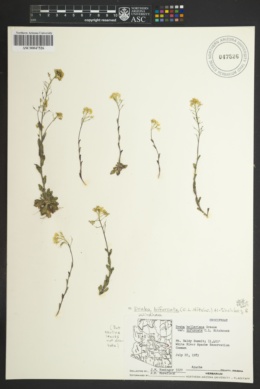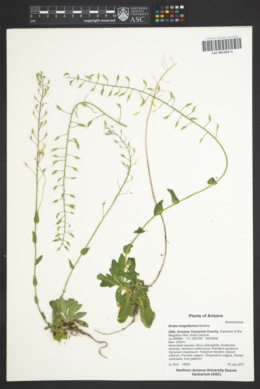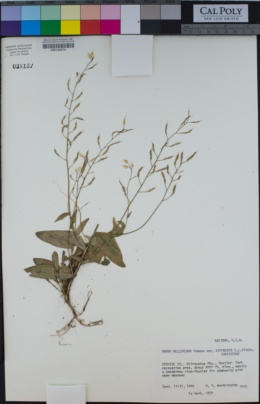Draba bifurcata
|
|
|
|
Family: Brassicaceae
Forked Whitlow-Grass, more...Heller's draba
[Draba helleriana var. bifurcata C.L. Hitchc.] |
Biennials or, rarely, perennials; caudex simple or branched; not scapose. Stems branched or unbranched, 1-3.9 dm, pubescent throughout or proximally, trichomes simple, 0.3-1.4 mm, often with smaller, 2 (or 3)-rayed ones. Basal leaves (soon withered); rosulate; petiolate; petiole ciliate, (trichomes simple, 0.4-1.1 mm); blade oblanceolate to spatulate, 1-7 cm × 2-12(-26) mm, margins entire or dentate (pubescent as petiole), surfaces pubescent, abaxially with simple trichomes, 0.6-1.1 mm, and stalked, 2- (or 3-)rayed ones, often smaller, adaxially with subsetiform, simple trichomes, 0.5-1.2 mm (rarely with fewer, stalked, 2-rayed ones). Cauline leaves (2-)6-15; sessile; blade lanceolate to ovate or oblong, margins dentate, surfaces pubescent as basal. Racemes 10-51-flowered, ebracteate, elongated in fruit; rachis glabrous or pubescent as stem, not flexuous. Fruiting pedicels horizontal to divaricate, straight, 4-15 mm, glabrous or pubescent, trichomes simple and 2-rayed. Flowers: sepals ovate, 2.5-3.2 mm, pubescent, (trichomes simple and short-stalked, 2-rayed); petals yellow, oblanceolate, 4.5-6.5 × 1.5-2 mm; anthers oblong, 0.8-1.1 mm. Fruits elliptic-lanceolate, twisted (1 turn or plane, flattened, 6-10 × 2-2.5 mm; valves glabrous or sparsely puberulent, trichomes simple, 0.05-0.15 mm; ovules 14-20 per ovary; style (1-)2-3 mm. Seeds oblong, 1.1-1.4 × 0.7-0.9 mm. Flowering Jun-Jul. Rocky areas, damp shady ravines, aspen-spruce communities; 1800-3600 m; Ariz. Draba bifurcata is distinguished from other North American species by a combination of yellow flowers with styles (1-)2-3 mm and almost exclusively simple trichomes on the abaxial surface of cauline leaf blades. It is known only from Chiricahua, Santa Catalina, and White mountains in Apache, Cochise, and Pima counties.
FNA 2010, Kearney and Peebles 1969, McDougal 1973 Duration: Perennial Nativity: Native Lifeform: Forb/Herb General: Herbaceous biennials to perennials, to 40 cm tall, stems 1-several, branching above, leafy to the inflorescence, herbage pubescent throughout or proximally, trichomes simple, with 2-3 rays. Leaves: Basal leaves soon withering in a basal rosette, blades oblanceolate to spatulate, 1-7 cm long and 2-12 mm wide, margins entire or dentate, cauline leaves alternate, few, 6-15, oblong, lanceolate, or ovate, 1-6 cm long, margins entire or shallowly dentate, both basal and cauline with pubescent surfaces. Flowers: Yellow, petals oblanceolate, 4-6.5 mm long, 1.5-2 mm wide, pubescent to glabrous, sepals ovate, 2.5-3 mm long, pubescent, flowers borne in dense racemes of 10-51 flowers, these without bracts, the racemes becoming elongate, 4-15 mm long, horizontal or divaricate in fruit. Fruits: Strongly compressed silicles, elliptic to oblong or linear, slightly to strongly twisted or plane, flattened, 6-10 mm long, 2-2.5 mm wide, valves glabrous to sparsely pubescent. Seeds numerous, oblong, to 1.5 mm long and 1 mm wide, biserate (in 2 rows). Ecology: Found on rocky soils in damp shady ravines, aspen-spruce communities, from 6,000-11,500 ft (1829-3353 m); flowering July-September. Distribution: This species is known only from the Chiricahua, Santa Catalina, and White mountains in Apache, Cochise, and Pima counties in Arizona. Notes: The sepals are good identifiers for this species, which are oblong in D. helleriana (which is very similar in many ways, and ovate in D. bifurcata. The main difference between this species and D. helleriana appear to the the stem hairs, which are simple or only once forked in D. bifurcata. The locality information for this species is taken from FNA, which shows a greater range restriction than in older texts. Ethnobotany: Unknown Synonyms: Draba helleriana var. bifurcata Editor: LCrumbacher 2011 Etymology: Draba comes from the Greek drabe for "sharp" or "acrid" and referring to the burning taste of the leaves which supposedly had a medicinal value as a poultice, while bifurcata likely means twice-forked. |


















